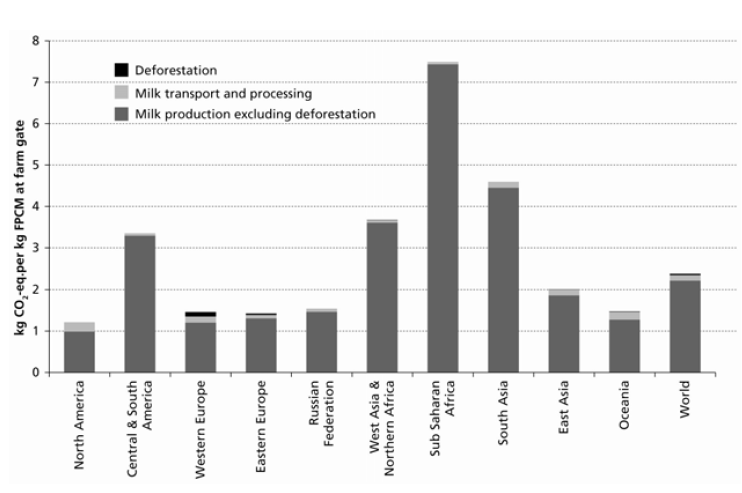In an earlier post, I wondered whether there were data on the relative carbon efficiency of agricultural production in Europe versus third countries. A recent FAO study arising from a collaborative effort by FAO and the International Dairy Federation which assesses GHG emissions from the dairy food chain throws light on this. The study uses a Life Cycle Analysis (LCA) approach, and thus includes the land use change induced by the consumption of feed (principally soybeans) in intensive dairy systems.
The results are unambiguous:
“A global trend emerging from the results is the lower level of emissions per unit of product in intensive compared to extensive systems. This is mainly driven by two factors: the higher digestibility of the animals’ feed, and the higher milk productivity level… However, it is possible that production systems in industrialised countries will experience increasing emissions with intensification, as the marginal reductions in emissions from enteric fermentation may not compensate for the increased emissions from manure, fossil energy and other inputs.” (p. 52).
The results are summarised in this graphic taken from the report. Total LCA emissions are broken down between production, deforestation and processing, although in all regions production is the largest single component. Western Europe, which is the largest producer of milk, is ranked only in third place as a producer of emissions.
Estimated GHG emissions per kg of standardised milk averaged over regions and the world

There are two implications from these results. The first, given the challenge of almost doubling global food production by 2050 from a 2000 base (70% increase over 2006), is the importance of efficiency improvements in helping to offset the additional GHG emissions we would otherwise expect from higher food production. Agricultural production is highly carbon intensive. The IPCC has reported that agriculture is responsible for over a quarter of anthropogenic GHG emissions, but accounts for only about 4 per cent of global GDP. Agricultural intensification, including but not only through the use of transgenic varieties, has a vital role in limiting the carbon footprint of more food production. A recent ICTSD paper by Tybbert and Sumner discusses the range of agricultural technologies open to developing countries to mitigate and adapt to climate change.
The second consequence has relevance to the debate on carbon leakage where EU agriculture is faced with a carbon price (either a tax or cap and trade system or regulations to limit emissions). Farm groups object to this in part because, in the absence of any measures to tackle consumption, such measures could lead to the displacement of EU production to third countries which are less carbon efficient (the issue of carbon leakage). As limiting the total amount of carbon emitted to the atmosphere is the main objective, such a consequence would clearly be nonsensical. At the same time, the option of excluding EU agriculture from efforts to meet the EU’s global carbon reduction commitments is not a satisfactory option either. One way to resolve this conundrum is to impose border tax adjustments on imports from third countries deemed not to be making an adequate effort to limit emissions, but the use of trade measures as part of carbon policy remains highly controversial.


Interesting FAO study if you look into it in detail. The general conclusion could be that a temperate climate is most apt for dairy farming with the least GHG emissions per kg product. But the ‘unambiguous’ conclusion as taken by Alan Matthews from the report can be misleading if one looks at intra-European differences between grassland and mixed dairy production. The system with grassland doesn’t necessitate any deforestation and is more compatible with sustainable soil management techniques, both of which imply that it has less GHG emission than the dairy production system conventionally described as ‘intensive’ in Europe, which feeds on arable crops such as soy and maize. That also can be concluded from the figures in the FAO report. Moreover, grassland systems can be more easily designed to include trees, which offset carbon emissions (in temperate agroforestry systems) quite substiantially. Transgenic varieties of arable crops on the contrary have no proven track record of mitigating or offsetting climate change.